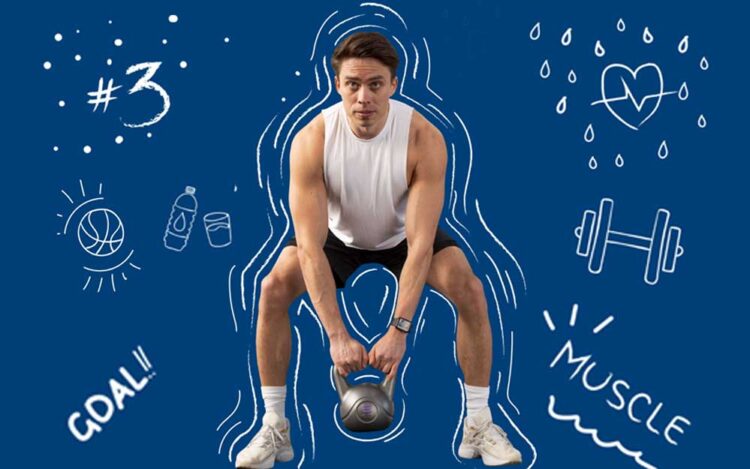Table of Contents
setting fitness goals is a fundamental step in building a successful fitness journey. A well-defined goal not only helps you stay focused but also keeps you motivated throughout. Setting fitness goals goes beyond merely deciding to “be active”; it’s about creating a detailed strategy that breaks down your objectives into small, manageable steps. This approach provides a clear path toward consistency, progress, and long-term achievement.
This article outlines effective steps for setting fitness goals to put you on the right track. Whether your aim is to gain strength, lose weight, or improve overall health, the process of defining and achieving goals is key to staying motivated and avoiding setbacks. By setting your fitness goals correctly, you can transform them into a sustainable and healthy lifestyle.
Key Takeaways:
- Success stories can serve as valuable inspiration for beginners on their fitness journey.
- By setting achievable goals, beginners can stay motivated and build confidence along the way.
- Breaking down big goals into smaller milestones can make the journey more manageable and motivating.
- Creating habits that align with fitness goals can provide daily motivation and support.
- Finding joy in the process and incorporating activities you enjoy can increase intrinsic motivation.
01
of 07
The Power of Visualization for Goal Setting
Visualization is an effective technique that can significantly impact the accomplishment of your fitness objectives. Research has shown that using visualization in your goal-setting process will improve the performance of your workout, frequency of exercise concentration, focus, and even confidence. By creating clear and vivid visual images in your mind of reaching your goals, it is possible to prepare your body and mind to be successful.
When you set fitness goals, you must imagine something that aligns with your values and passion. When you set your sights on a goal that you connect with at a deeper level, it creates a strong determination that pushes you out of your comfort zone and forces you to follow through with your actions.
Studies have shown that the mind can’t tell between an imaginative experience and a reality. If you keep visualizing yourself as a success at achieving your fitness goals, you are sending powerful messages in your subconscious mind that the goal is possible. This process of visualization strengthens neural pathways linked to your goals, resulting in confidence and confidence that pushes you towards your goals.
Incorporating visualization into your routine, you build the picture of the desired result and strengthen your commitment to reaching it. Find a peaceful space in which you can unwind and clear your thoughts. Put your head in a corner and picture you are engaged in actions that lead to the achievement of your objectives. Imagine yourself doing exercises with enthusiasm and feeling confident. Visualize yourself making good choices for yourself, eating nutritious meals, and always taking care of your health.
Visualization can also aid in increasing the frequency of exercise by creating an imaginary rehearsal of your exercise routine. When you mentally practice your workouts prior to doing them, you can improve your physical fitness and increase the memory of your muscles. It is possible to visualize the exact exercises set-ups, sets, and reps and imagine yourself performing each move effortlessly and with ease.
The more you participate in visualization and meditation, the more you’ll find that your subconscious mind accepts the goals you set and aligns your emotions, thoughts, and actions toward achieving them. When you regularly engage in this mental picture, it increases your confidence and dedication to your fitness goal.
Visualization is a powerful tool that can heighten your motivation, improve exercise frequency, and increase your confidence. By vividly imagining yourself successfully achieving your fitness goals, you create a solid foundation for success and propel yourself towards exceptional results.

Visualization Techniques for Setting Fitness Goals
A powerful form of visualization increases your chance in achieving your fitness goals through mentally preparing your body’s muscles to tackle the challenges to achieve desired results. When you imagine yourself doing specific exercises or attaining certain fitness levels or milestones, your mind gets activated through those same neural pathways, even when you do the work. Mental exercise increases the ability to perform exercise more efficiently, making your goal of fitness more achievable.
The Crucial Benefits of Visualization in setting goals in fitness
- Improve performance: Strategies for visualizing improve neural connections, leading to better efficiency when playing activities. Through mental repetition of your exercise routine, you’ll increase your ability to move and become skilled in executing certain movements.
- Increased Confidence: Regular exercise in the visual realm builds confidence in your abilities and increase your confidence. The satisfaction that you can see yourself succeed mentally will help you prepare for life in the real world. It also will make you feel better and more motivated to achieve your fitness goals.
- Enhances the frequency of exercising. The power of visualization can serve as a motivational factor. If you imagine yourself working out and overcoming obstacles, it can reduce obstacles to exercising and increases your exercise frequency. This is extremely effective when it comes to staying with the fitness regimen you’re currently following.
- Greater Focus: Visualization is a great way to increase focus and concentrate during workouts. Through rehearsing mental goals for fitness along with how to reach these goals, you can develop more concentration and dedication that allows you to focus and remain clear of distracting thoughts.
In a study, which was published in The Journal of Sports Sciences Researchers found that those who practiced regular visualization did not only gain performance, however, they also experienced more confidence. Similar to the study above, one released within the Journal of Aging and Physical Activity discovered that those older than 65 who engaged in visualization improved their motivation to exercise as well as adhering to.
Utilizing these strategies for visualization, making use of these techniques for visualization to create an image which is crystal unambiguous in your thoughts about the progress you have made in your fitness and set your self to achieve success. Visualization is not only a method to determine your fitness goals; it can also help you overcome your limitations and reach the next step in your fitness goals.
The Pro-Tip Start with just a few moments each day to imagine your fitness goals. Visualize yourself exercising to leave with a feeling of energy and joy, while also celebrate your successes. A simple routine can make huge difference in turning the fitness dreams you have set into realization.
02
of 07
How to Break Down Your Fitness Goals into Achievable Milestones
At the beginning of an exercise program, people who are new typically set ambitious targets for themselves, including losing weight. While these goals may be motivating, they may also seem overwhelming and result in feeling unmotivated. This is why goal breakdown is important.
Breakdown is a technique that involves breaking down a large target into smaller, less attainable targets. Instead of solely focusing on the overall weight loss goal, novices can set small goals, for example, losing one pound at a stretch. This method allows for gradual success and gives you a constant feeling of satisfaction as you progress.
By breaking down significant goals, novices can reap the benefits of incremental success. Each little milestone achieved gives a euphoria of accomplishment and moves the goal closer. This feeling of achievement keeps the motivation up and motivates those who work hard to achieve the ultimate goal.
Let’s take a look at an example:
| Goal Breakdown: Weight Loss Journey | Incremental Success |
|---|---|
| Starting Weight: 200 pounds | – |
| Milestone 1: Lose 5 pounds | 5 pounds lost |
| Milestone 2: Lose 10 pounds | 15 pounds lost |
| Milestone 3: Lose 15 pounds | 30 pounds lost |
| Milestone 4: Lose 20 pounds | 50 pounds lost |
| Ultimate Goal: Lose 50 pounds | Goal achieved! |
As you can see in the above table, breaking down your weight loss goals into smaller stages gives you elation at every step. This gradual success keeps you motivated and helps newbies keep their focus.
Remember that the goal of goal breakdown isn’t to reduce the significance of the final goal; instead, it is to give the necessary guidelines for the achievement. By focusing on smaller, more manageable goals, novices can gain an ongoing drive and develop the confidence required to achieve their goals.
03
of 07
Creating Daily Habits That Support Your Fitness Goals
The importance of establishing routines based on goals is for ensuring lasting results in achieving the fitness targets. Through integrating daily routines in line with the monthly goals Beginners can stay focused and motivated about their fitness objectives.
One of the best ways to stay on the right track is to note down the specific tasks you need to complete and create your daily schedule aligned with your objectives. When you’re making time for exercise each morning or cooking food for the day, making daily chores can help create a dependable and organized method.
Participating in focused practices, such as meditation and deep breathing can help you stay focused and maintain enthusiasm. These activities help to calm your mind, remove distractions and improve your the concentration of your mind, which allows your mind to be focused upon the task before you.
Remember, building goal-supporting habits takes time and effort. It’s important to be consistent and patient with yourself as you form these habits. Small steps each day can lead to significant progress over time.
Benefits of goal-supporting habits:
- Increased motivation and focus
- Greater consistency in daily tasks
- Improved time management skills
- Enhanced mental clarity and concentration
- Reduced stress and anxiety
Integrating specific exercises into your everyday routine can help you build a strong basis for hitting your fitness goals.
| Goal-Supporting Habits | Daily Tasks |
|---|---|
| 1. Morning Workout | – Perform a 30-minute cardio workout |
| 2. Healthy Eating | – Prepare healthy meals and snacks in advance |
| 3. Hydration | – Drink at least 8 glasses of water per day |
| 4. Sleep Schedule | – Establish a consistent sleep schedule |
| 5. Focus Exercises | – Practice deep breathing and meditation |
04
of 07
Finding Motivation by Setting Fitness Goals That Challenge You
Setting goals that are challenging yet achievable is crucial for beginners to stay motivated on their fitness journey. Research indicates that goals that are just beyond reach can increase motivation and excitement, propelling individuals to push past their limits and achieve remarkable results. However, it’s equally important to consider one’s fitness level, body type, and personal needs when setting these goals, in order to avoid underestimation or setting unrealistic expectations.
When determining achievable goals, it’s essential to assess your current fitness level objectively. This assessment can be done through various methods, such as consulting with a fitness professional or using specialized fitness assessment tools. By understanding your starting point and your potential for growth, you can set realistic yet challenging goals that align with your capabilities.

Avoid underestimating your abilities as you set your fitness goals. Underestimating can lead to complacency and hinder progress, while overestimating may lead to disappointment and frustration. By finding the right balance between challenge and achievability, you can maintain motivation and measure your progress effectively.
One strategy for setting challenging yet achievable goals is to gradually increase the difficulty of your fitness routine. Start with realistic short-term goals and gradually level up the intensity or duration as you progress. For example, if your initial goal is to run for 10 minutes straight, aim for 15 minutes in the following weeks and gradually increase from there.
Quote:
Remember that what is achievable for someone else may not necessarily be the same for you. It’s crucial to focus on your own journey and set goals that challenge and inspire you personally. – Fitness Expert, Lisa Thompson.
By setting challenging yet achievable goals, you can keep yourself motivated and continuously strive for progress. Remember to celebrate your achievements along the way and adapt your goals as your fitness level improves. With dedication and perseverance, you can reach new heights in your fitness journey.
05
of 07
Setting Fitness Goals You’ll Enjoy Pursuing Every Day
When it comes to embarking on a fitness journey, finding joy in the process can play a crucial role in keeping beginners motivated. It’s not just about hitting the gym or sticking to a strict diet; it’s about engaging in activities that you genuinely enjoy and incorporating them into your fitness goals. Research has consistently shown that people who find joy in what they’re doing tend to feel more confident, perform better, and stay motivated for the long haul.
Intrinsic motivation, or the internal drive to engage in an activity for its own sake, plays a significant role in sustaining motivation. By pursuing activities that bring you joy, you tap into this intrinsic motivation, making your fitness journey more enjoyable and fulfilling. As you engage in activities you genuinely love, you build a positive connection between your personal interests and your fitness goals.
“The best way to stay motivated is to find joy in the process. When you enjoy what you’re doing, it doesn’t feel like a chore, but rather something you look forward to every day. It becomes a part of your lifestyle, and that’s when you truly find success.” – Sarah Johnson, Fitness Enthusiast
Finding Your Fit
Everyone has different preferences when it comes to physical activities. Some might enjoy running, while others prefer dancing or practicing yoga. The key is to explore various activities and find what brings you joy. Experiment with different forms of exercise and movement until you discover something that truly resonates with you.
By incorporating activities you enjoy into your fitness routine, you’ll not only find yourself looking forward to each workout but also experiencing intrinsic motivation throughout the process. Whether it’s joining a sports team, taking dance classes, or going hiking with friends, the options are endless. The important thing is to find what makes you happy and work that into your fitness goals.

Benefits of Finding Joy
When you find joy in the process of pursuing your fitness goals, several benefits come along with it:
- Increased Motivation: Engaging in activities you genuinely enjoy sparks motivation from within, helping you stay committed to your fitness routine.
- Greater Satisfaction: Finding joy in what you’re doing adds a sense of fulfillment and satisfaction to your fitness journey.
- Improved Performance: Enjoyment leads to higher levels of focus and concentration, which can enhance your performance and overall success.
- Building Sustainable Habits: When you incorporate activities you love into your fitness routine, it becomes easier to maintain a sustainable and long-term habit.
Remember, fitness should be fun. Don’t be afraid to experiment and try new things until you discover what brings you joy on your fitness journey. Embrace the activities you love, and let them become an integral part of your motivation and success.
06
of 07
Conclusion
Setting fitness goals can be a powerful motivator for beginners. By following a step-by-step guide, utilizing visualization techniques, breaking down goals, creating supportive habits, and finding joy in the process, beginners can reach their goals and establish a sustainable fitness routine. Success stories from other beginners can provide inspiration and motivation along the way.
Keep pushing forward and celebrate each achievement, as reaching goals is within reach with dedication and perseverance. By incorporating these strategies into your fitness journey, you can create a sustainable routine that supports your long-term success. Remember, everyone starts as a beginner, and your success story can inspire others to start their own fitness journey too.














